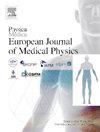Proof of concept of near real-time intra-fractional 3D monitoring of prostate position using a scheme based on the skeletonization of implanted marker images and recursive least squares approximation motion tracking
IF 3.3
3区 医学
Q1 RADIOLOGY, NUCLEAR MEDICINE & MEDICAL IMAGING
Physica Medica-European Journal of Medical Physics
Pub Date : 2025-05-29
DOI:10.1016/j.ejmp.2025.105009
引用次数: 0
Abstract
Background
The on-board imaging system using monoscopic X-ray technology struggles to detect motion along the beam direction. This study presents a method that combines skeletonization for marker recognition with a Recursive Least Squares Approximation (RLSA) algorithm to convert 2D motion data into a 3D representation.
Methods
Fiducial markers were represented as 2D lines through masking and skeletonization of paired-planar images, allowing for the construction of a 3D motion model. An iterative closest point (ICP) algorithm determined the 6D transformation from online to planning images. The accuracy of 3D motion estimation was evaluated across various angular separations (10°–170°) for both large (10 mm, 3°) and small (3 mm) marker offsets. The RLSA algorithm was validated against different motion drift patterns.
Results
The marker recognition process was robust against varying contrast noise ratios. Mean errors of various angle separation tests in the X and Y directions were within 0.3 mm for large offsets and 0.2 mm for small offsets across all angular separations. With The RLSA applied at 10-° intervals during a 360-° gantry rotation, mean errors in the beam direction for continuous drift and low, intermediate, and high-frequency excursions were (0.2 ± 0.3) mm, (0.2 ± 0.3) mm, (0.4 ± 0.5) mm, and (0.4 ± 0.5) mm, respectively, with a maximum error of 1.3 mm across all excursion conditions.
Conclusion
The proposed method demonstrates significant potential in effectively converting 2D motion into 3D and enabling real-time 3D motion tracking during intrafraction radiation therapy.
基于植入标记图像的骨架化和递归最小二乘近似运动跟踪的前列腺位置的近实时分段内三维监测的概念证明
使用单镜x射线技术的机载成像系统很难探测到光束方向上的运动。本研究提出了一种将标记识别的骨架化与递归最小二乘近似(RLSA)算法相结合的方法,将2D运动数据转换为3D表示。方法对平面配对图像进行掩蔽和骨架化处理,将基准标记物表示为二维直线,构建三维运动模型。迭代最近点(ICP)算法确定了在线图像到规划图像的6D转换。对大(10 mm, 3°)和小(3 mm)标记偏移量进行了不同角度间隔(10°-170°)的3D运动估计精度评估。针对不同的运动漂移模式对RLSA算法进行了验证。结果该标记识别过程对不同对比度噪声比具有较强的鲁棒性。各种角度分离试验在X和Y方向上的平均误差在所有角度分离中,大偏移量在0.3 mm以内,小偏移量在0.2 mm以内。在360°龙门旋转期间,以10°间隔应用RLSA,连续漂移和低、中、高频偏移的光束方向平均误差分别为(0.2±0.3)mm,(0.2±0.3)mm,(0.4±0.5)mm和(0.4±0.5)mm,所有偏移条件下的最大误差为1.3 mm。结论该方法可有效地将二维运动转换为三维运动,并可在屈光度内放疗过程中实现实时三维运动跟踪。
本文章由计算机程序翻译,如有差异,请以英文原文为准。
求助全文
约1分钟内获得全文
求助全文
来源期刊
CiteScore
6.80
自引率
14.70%
发文量
493
审稿时长
78 days
期刊介绍:
Physica Medica, European Journal of Medical Physics, publishing with Elsevier from 2007, provides an international forum for research and reviews on the following main topics:
Medical Imaging
Radiation Therapy
Radiation Protection
Measuring Systems and Signal Processing
Education and training in Medical Physics
Professional issues in Medical Physics.

 求助内容:
求助内容: 应助结果提醒方式:
应助结果提醒方式:


